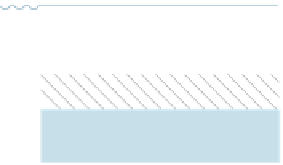Geoscience Reference
In-Depth Information
fraction remains between crystals depending on the growth speed. As a result, the salinity
of ice is an order of magnitude less than the salinity of the parent water (Lepp
ä
ranta et al.
2003b). This may cause weak convection in the surface layer. More signi
cant is the melt
water, which is less saline, and therefore less dense, than the lake water, and which may
form a thin stable layer under the ice.
4.2.3 Superimposed Ice Growth
Superimposed ice grows above the top surface of the ice sheet (see Sect.
3.2.2
). The
dominant type is freezing of slush, which is a mixture of snow and liquid water from the
lake, rain or snowmelt (Fig.
4.7
). But also rain water or melt water ponds on ice may
freeze into superimposed ice. When the slush has formed, ice grows from its upper
surface. The growth law is as in the case of snow-covered congelation ice, but the latent
heat released is reduced since slush contains ice crystals. Also there is no heat
flux from
the slush to the bottom of the growing snow-ice. Consequently, the boundary condition (
4.
25c
) is replaced by
fl
qm
L
f
dh
dt
¼ k
@
T
ð
4
:
30
Þ
@
z
where
ν
is the liquid water content of the slush. Observations suggest that typically
ν
*
½
when slush forms by
ranta and Kosloff 2000), and then, with the
same temperature gradient, snow-ice growth rate is twice the growth rate of congelation
ice. Snow-ice growth is thus similar to snow-covered congelation ice, modi
fl
flooding (e.g., Lepp
ä
ed by the
porosity in
uence.
If the underlying ice is very cold, the slush may also freeze at its bottom but this growth
remains limited. Using the
fl
'
cold content of the ice
'
to place the latent heat of freezing, the
growth of the slush layer at the ice
slush interface (
ʔ
h) is obtained from
-
ˁ
cTh =
ˁν
L
f
ʔ
h,
-
where h is the thickness of congelation ice; if the mean temperature of
½
m thick ice is
h = 3 cm.
the case of slush produced by
5
°
C, we have
ʔ
-
fl
flooding, there is always snow on top of the snow-ice
Fig. 4.6
Schematic cross-
section of snow on lake ice: top
layer is above the water surface
level, and beneath snow is
found in snow-ice and slush
layers
Dry snow
Water
level
New snow - ice
Slush
Old snow - ice
Congelation ice



















































Search WWH ::

Custom Search